Accounting Information System in Baking
VerifiedAdded on 2020/02/18
|7
|1370
|410
AI Summary
This assignment delves into the application of accounting principles within the baking industry. It analyzes the baking process, highlighting key steps and their corresponding financial implications. The document also examines the role of accounting in managing a bakery business, emphasizing the importance of accurate record-keeping and financial analysis.
Contribute Materials
Your contribution can guide someone’s learning journey. Share your
documents today.
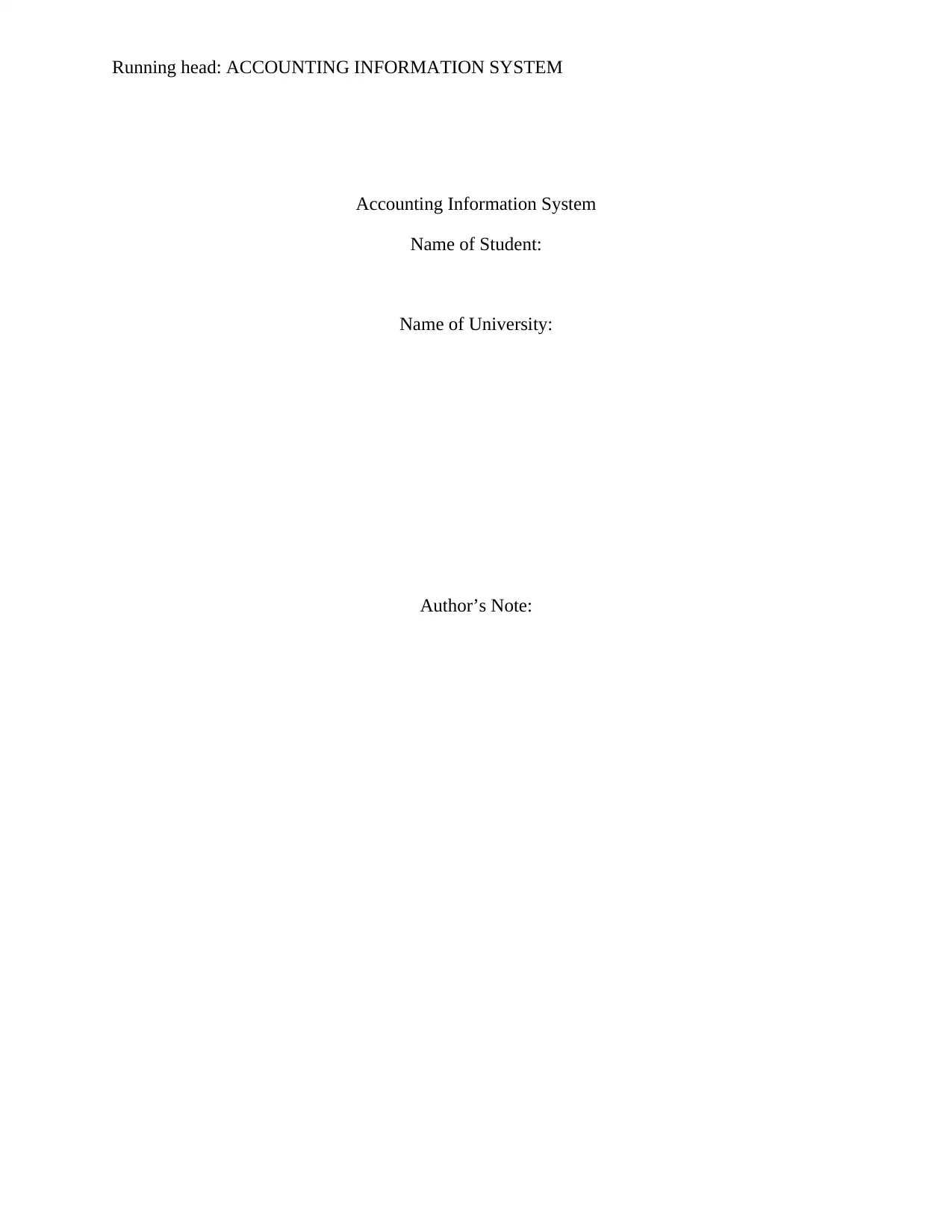
Running head: ACCOUNTING INFORMATION SYSTEM
Accounting Information System
Name of Student:
Name of University:
Author’s Note:
Accounting Information System
Name of Student:
Name of University:
Author’s Note:
Secure Best Marks with AI Grader
Need help grading? Try our AI Grader for instant feedback on your assignments.
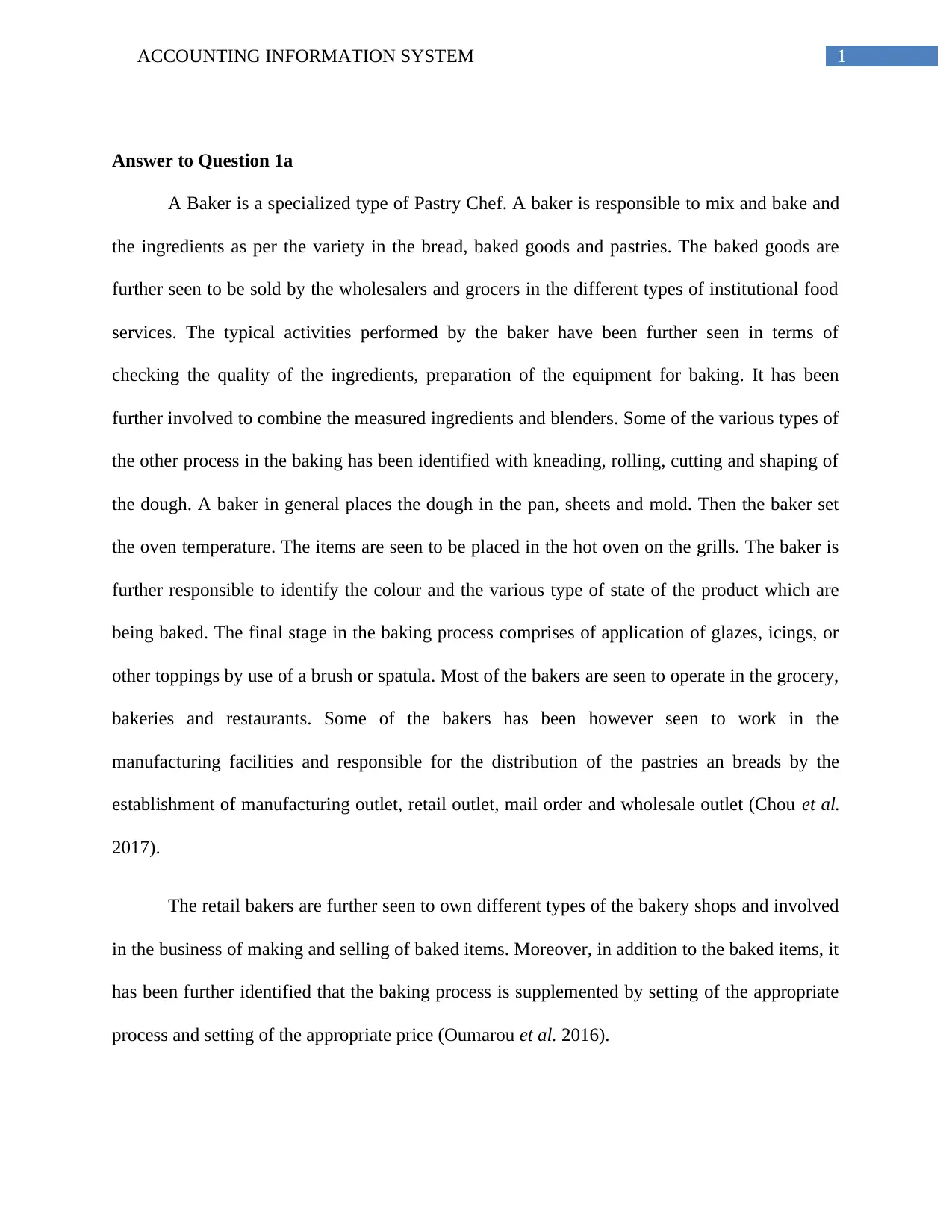
1ACCOUNTING INFORMATION SYSTEM
Answer to Question 1a
A Baker is a specialized type of Pastry Chef. A baker is responsible to mix and bake and
the ingredients as per the variety in the bread, baked goods and pastries. The baked goods are
further seen to be sold by the wholesalers and grocers in the different types of institutional food
services. The typical activities performed by the baker have been further seen in terms of
checking the quality of the ingredients, preparation of the equipment for baking. It has been
further involved to combine the measured ingredients and blenders. Some of the various types of
the other process in the baking has been identified with kneading, rolling, cutting and shaping of
the dough. A baker in general places the dough in the pan, sheets and mold. Then the baker set
the oven temperature. The items are seen to be placed in the hot oven on the grills. The baker is
further responsible to identify the colour and the various type of state of the product which are
being baked. The final stage in the baking process comprises of application of glazes, icings, or
other toppings by use of a brush or spatula. Most of the bakers are seen to operate in the grocery,
bakeries and restaurants. Some of the bakers has been however seen to work in the
manufacturing facilities and responsible for the distribution of the pastries an breads by the
establishment of manufacturing outlet, retail outlet, mail order and wholesale outlet (Chou et al.
2017).
The retail bakers are further seen to own different types of the bakery shops and involved
in the business of making and selling of baked items. Moreover, in addition to the baked items, it
has been further identified that the baking process is supplemented by setting of the appropriate
process and setting of the appropriate price (Oumarou et al. 2016).
Answer to Question 1a
A Baker is a specialized type of Pastry Chef. A baker is responsible to mix and bake and
the ingredients as per the variety in the bread, baked goods and pastries. The baked goods are
further seen to be sold by the wholesalers and grocers in the different types of institutional food
services. The typical activities performed by the baker have been further seen in terms of
checking the quality of the ingredients, preparation of the equipment for baking. It has been
further involved to combine the measured ingredients and blenders. Some of the various types of
the other process in the baking has been identified with kneading, rolling, cutting and shaping of
the dough. A baker in general places the dough in the pan, sheets and mold. Then the baker set
the oven temperature. The items are seen to be placed in the hot oven on the grills. The baker is
further responsible to identify the colour and the various type of state of the product which are
being baked. The final stage in the baking process comprises of application of glazes, icings, or
other toppings by use of a brush or spatula. Most of the bakers are seen to operate in the grocery,
bakeries and restaurants. Some of the bakers has been however seen to work in the
manufacturing facilities and responsible for the distribution of the pastries an breads by the
establishment of manufacturing outlet, retail outlet, mail order and wholesale outlet (Chou et al.
2017).
The retail bakers are further seen to own different types of the bakery shops and involved
in the business of making and selling of baked items. Moreover, in addition to the baked items, it
has been further identified that the baking process is supplemented by setting of the appropriate
process and setting of the appropriate price (Oumarou et al. 2016).
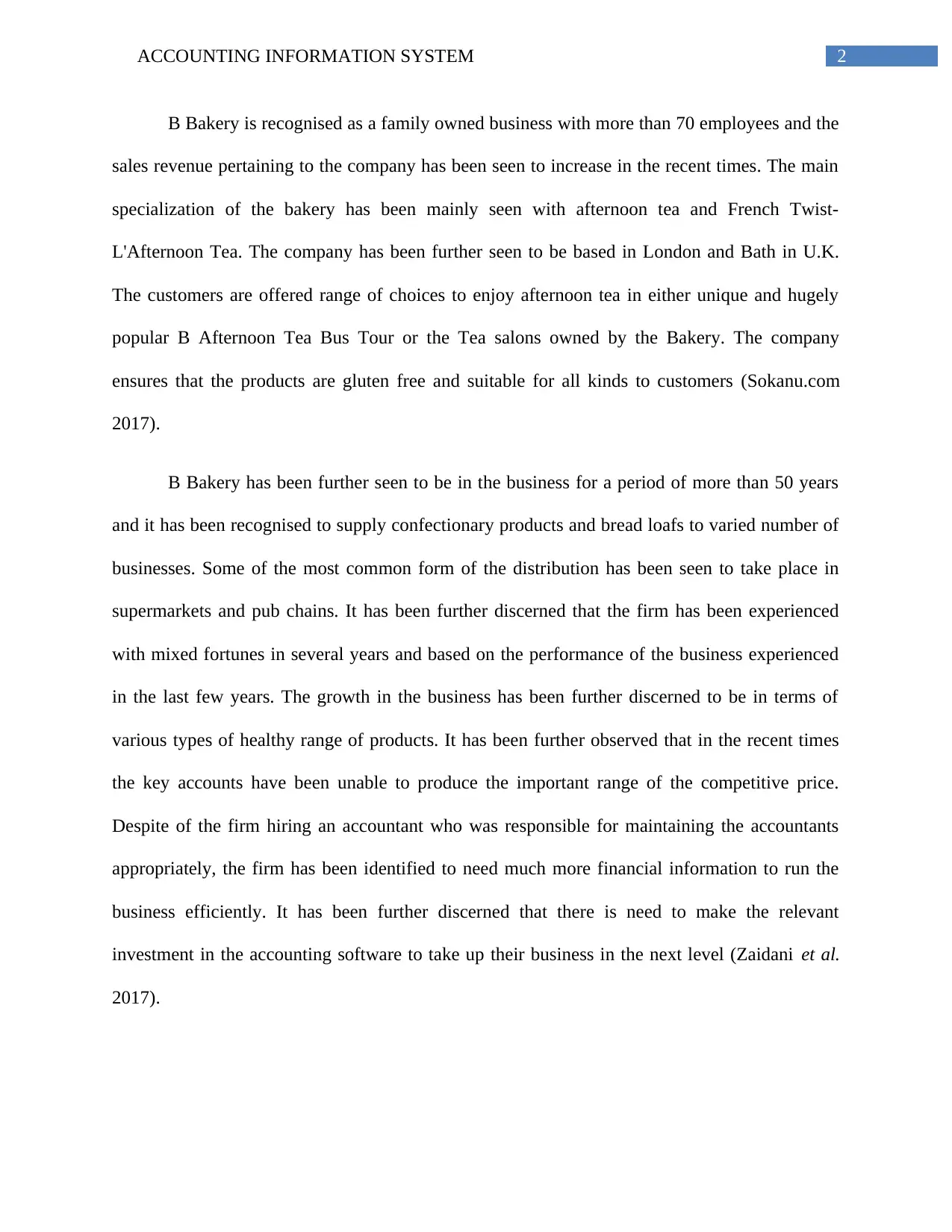
2ACCOUNTING INFORMATION SYSTEM
B Bakery is recognised as a family owned business with more than 70 employees and the
sales revenue pertaining to the company has been seen to increase in the recent times. The main
specialization of the bakery has been mainly seen with afternoon tea and French Twist-
L'Afternoon Tea. The company has been further seen to be based in London and Bath in U.K.
The customers are offered range of choices to enjoy afternoon tea in either unique and hugely
popular B Afternoon Tea Bus Tour or the Tea salons owned by the Bakery. The company
ensures that the products are gluten free and suitable for all kinds to customers (Sokanu.com
2017).
B Bakery has been further seen to be in the business for a period of more than 50 years
and it has been recognised to supply confectionary products and bread loafs to varied number of
businesses. Some of the most common form of the distribution has been seen to take place in
supermarkets and pub chains. It has been further discerned that the firm has been experienced
with mixed fortunes in several years and based on the performance of the business experienced
in the last few years. The growth in the business has been further discerned to be in terms of
various types of healthy range of products. It has been further observed that in the recent times
the key accounts have been unable to produce the important range of the competitive price.
Despite of the firm hiring an accountant who was responsible for maintaining the accountants
appropriately, the firm has been identified to need much more financial information to run the
business efficiently. It has been further discerned that there is need to make the relevant
investment in the accounting software to take up their business in the next level (Zaidani et al.
2017).
B Bakery is recognised as a family owned business with more than 70 employees and the
sales revenue pertaining to the company has been seen to increase in the recent times. The main
specialization of the bakery has been mainly seen with afternoon tea and French Twist-
L'Afternoon Tea. The company has been further seen to be based in London and Bath in U.K.
The customers are offered range of choices to enjoy afternoon tea in either unique and hugely
popular B Afternoon Tea Bus Tour or the Tea salons owned by the Bakery. The company
ensures that the products are gluten free and suitable for all kinds to customers (Sokanu.com
2017).
B Bakery has been further seen to be in the business for a period of more than 50 years
and it has been recognised to supply confectionary products and bread loafs to varied number of
businesses. Some of the most common form of the distribution has been seen to take place in
supermarkets and pub chains. It has been further discerned that the firm has been experienced
with mixed fortunes in several years and based on the performance of the business experienced
in the last few years. The growth in the business has been further discerned to be in terms of
various types of healthy range of products. It has been further observed that in the recent times
the key accounts have been unable to produce the important range of the competitive price.
Despite of the firm hiring an accountant who was responsible for maintaining the accountants
appropriately, the firm has been identified to need much more financial information to run the
business efficiently. It has been further discerned that there is need to make the relevant
investment in the accounting software to take up their business in the next level (Zaidani et al.
2017).
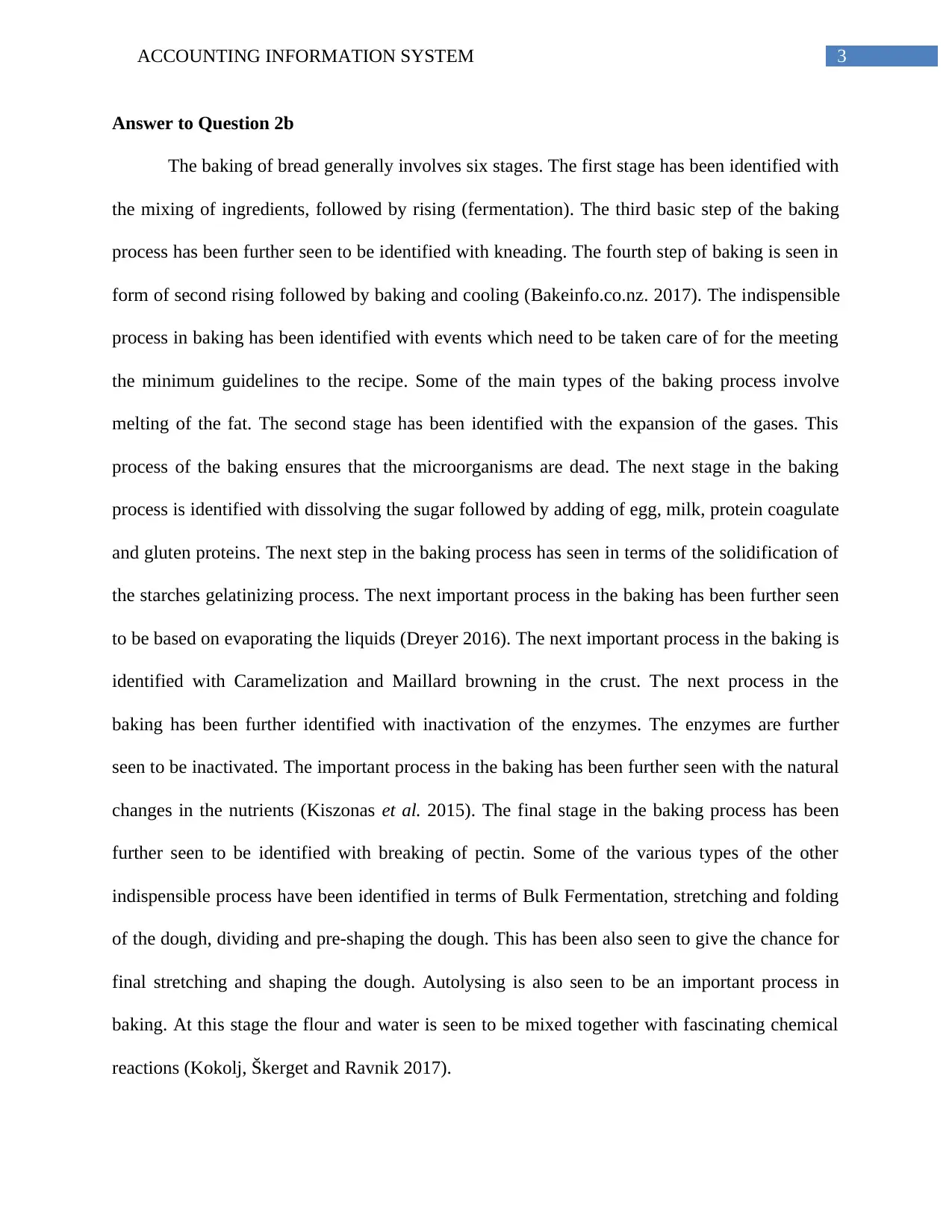
3ACCOUNTING INFORMATION SYSTEM
Answer to Question 2b
The baking of bread generally involves six stages. The first stage has been identified with
the mixing of ingredients, followed by rising (fermentation). The third basic step of the baking
process has been further seen to be identified with kneading. The fourth step of baking is seen in
form of second rising followed by baking and cooling (Bakeinfo.co.nz. 2017). The indispensible
process in baking has been identified with events which need to be taken care of for the meeting
the minimum guidelines to the recipe. Some of the main types of the baking process involve
melting of the fat. The second stage has been identified with the expansion of the gases. This
process of the baking ensures that the microorganisms are dead. The next stage in the baking
process is identified with dissolving the sugar followed by adding of egg, milk, protein coagulate
and gluten proteins. The next step in the baking process has seen in terms of the solidification of
the starches gelatinizing process. The next important process in the baking has been further seen
to be based on evaporating the liquids (Dreyer 2016). The next important process in the baking is
identified with Caramelization and Maillard browning in the crust. The next process in the
baking has been further identified with inactivation of the enzymes. The enzymes are further
seen to be inactivated. The important process in the baking has been further seen with the natural
changes in the nutrients (Kiszonas et al. 2015). The final stage in the baking process has been
further seen to be identified with breaking of pectin. Some of the various types of the other
indispensible process have been identified in terms of Bulk Fermentation, stretching and folding
of the dough, dividing and pre-shaping the dough. This has been also seen to give the chance for
final stretching and shaping the dough. Autolysing is also seen to be an important process in
baking. At this stage the flour and water is seen to be mixed together with fascinating chemical
reactions (Kokolj, Škerget and Ravnik 2017).
Answer to Question 2b
The baking of bread generally involves six stages. The first stage has been identified with
the mixing of ingredients, followed by rising (fermentation). The third basic step of the baking
process has been further seen to be identified with kneading. The fourth step of baking is seen in
form of second rising followed by baking and cooling (Bakeinfo.co.nz. 2017). The indispensible
process in baking has been identified with events which need to be taken care of for the meeting
the minimum guidelines to the recipe. Some of the main types of the baking process involve
melting of the fat. The second stage has been identified with the expansion of the gases. This
process of the baking ensures that the microorganisms are dead. The next stage in the baking
process is identified with dissolving the sugar followed by adding of egg, milk, protein coagulate
and gluten proteins. The next step in the baking process has seen in terms of the solidification of
the starches gelatinizing process. The next important process in the baking has been further seen
to be based on evaporating the liquids (Dreyer 2016). The next important process in the baking is
identified with Caramelization and Maillard browning in the crust. The next process in the
baking has been further identified with inactivation of the enzymes. The enzymes are further
seen to be inactivated. The important process in the baking has been further seen with the natural
changes in the nutrients (Kiszonas et al. 2015). The final stage in the baking process has been
further seen to be identified with breaking of pectin. Some of the various types of the other
indispensible process have been identified in terms of Bulk Fermentation, stretching and folding
of the dough, dividing and pre-shaping the dough. This has been also seen to give the chance for
final stretching and shaping the dough. Autolysing is also seen to be an important process in
baking. At this stage the flour and water is seen to be mixed together with fascinating chemical
reactions (Kokolj, Škerget and Ravnik 2017).
Secure Best Marks with AI Grader
Need help grading? Try our AI Grader for instant feedback on your assignments.

4ACCOUNTING INFORMATION SYSTEM
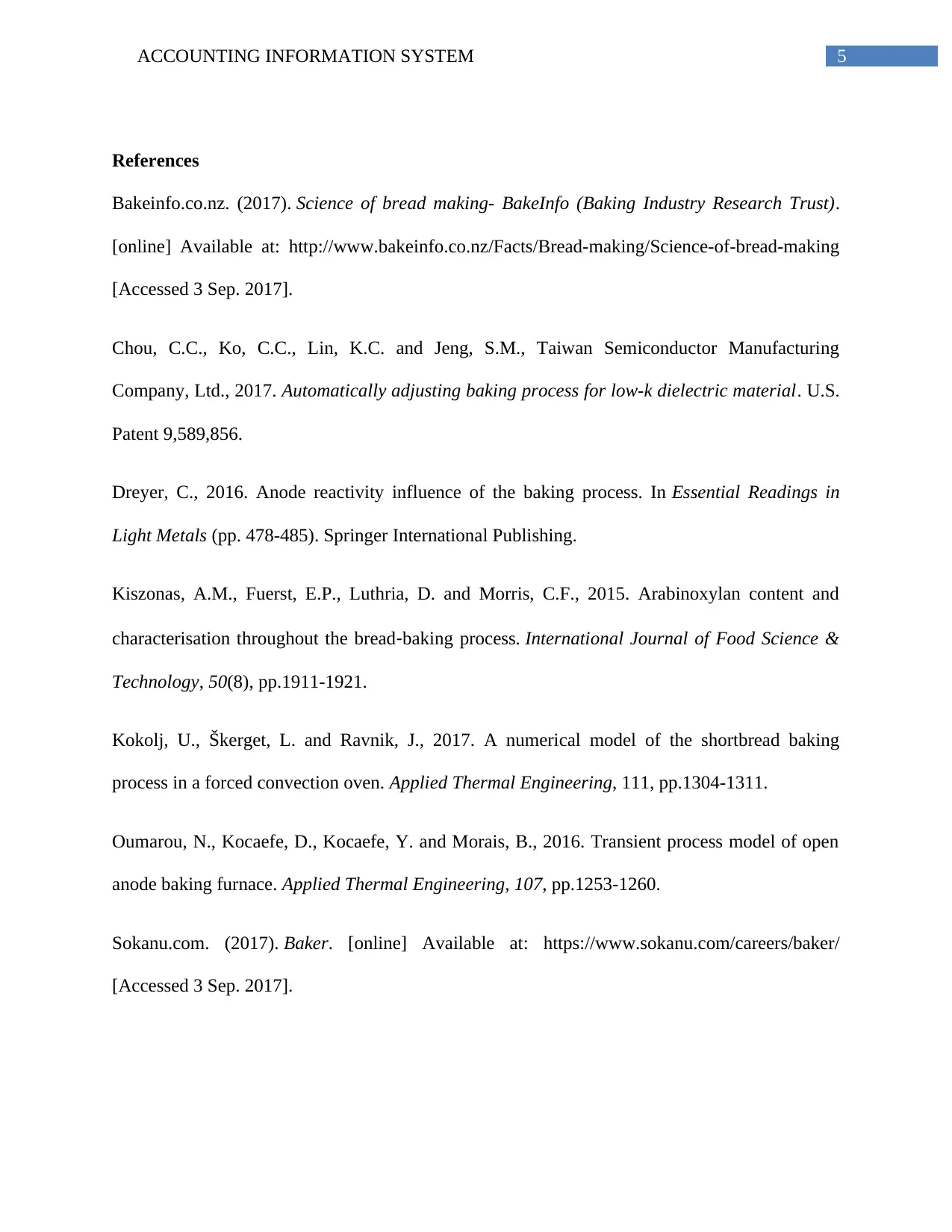
5ACCOUNTING INFORMATION SYSTEM
References
Bakeinfo.co.nz. (2017). Science of bread making- BakeInfo (Baking Industry Research Trust).
[online] Available at: http://www.bakeinfo.co.nz/Facts/Bread-making/Science-of-bread-making
[Accessed 3 Sep. 2017].
Chou, C.C., Ko, C.C., Lin, K.C. and Jeng, S.M., Taiwan Semiconductor Manufacturing
Company, Ltd., 2017. Automatically adjusting baking process for low-k dielectric material. U.S.
Patent 9,589,856.
Dreyer, C., 2016. Anode reactivity influence of the baking process. In Essential Readings in
Light Metals (pp. 478-485). Springer International Publishing.
Kiszonas, A.M., Fuerst, E.P., Luthria, D. and Morris, C.F., 2015. Arabinoxylan content and
characterisation throughout the bread‐baking process. International Journal of Food Science &
Technology, 50(8), pp.1911-1921.
Kokolj, U., Škerget, L. and Ravnik, J., 2017. A numerical model of the shortbread baking
process in a forced convection oven. Applied Thermal Engineering, 111, pp.1304-1311.
Oumarou, N., Kocaefe, D., Kocaefe, Y. and Morais, B., 2016. Transient process model of open
anode baking furnace. Applied Thermal Engineering, 107, pp.1253-1260.
Sokanu.com. (2017). Baker. [online] Available at: https://www.sokanu.com/careers/baker/
[Accessed 3 Sep. 2017].
References
Bakeinfo.co.nz. (2017). Science of bread making- BakeInfo (Baking Industry Research Trust).
[online] Available at: http://www.bakeinfo.co.nz/Facts/Bread-making/Science-of-bread-making
[Accessed 3 Sep. 2017].
Chou, C.C., Ko, C.C., Lin, K.C. and Jeng, S.M., Taiwan Semiconductor Manufacturing
Company, Ltd., 2017. Automatically adjusting baking process for low-k dielectric material. U.S.
Patent 9,589,856.
Dreyer, C., 2016. Anode reactivity influence of the baking process. In Essential Readings in
Light Metals (pp. 478-485). Springer International Publishing.
Kiszonas, A.M., Fuerst, E.P., Luthria, D. and Morris, C.F., 2015. Arabinoxylan content and
characterisation throughout the bread‐baking process. International Journal of Food Science &
Technology, 50(8), pp.1911-1921.
Kokolj, U., Škerget, L. and Ravnik, J., 2017. A numerical model of the shortbread baking
process in a forced convection oven. Applied Thermal Engineering, 111, pp.1304-1311.
Oumarou, N., Kocaefe, D., Kocaefe, Y. and Morais, B., 2016. Transient process model of open
anode baking furnace. Applied Thermal Engineering, 107, pp.1253-1260.
Sokanu.com. (2017). Baker. [online] Available at: https://www.sokanu.com/careers/baker/
[Accessed 3 Sep. 2017].
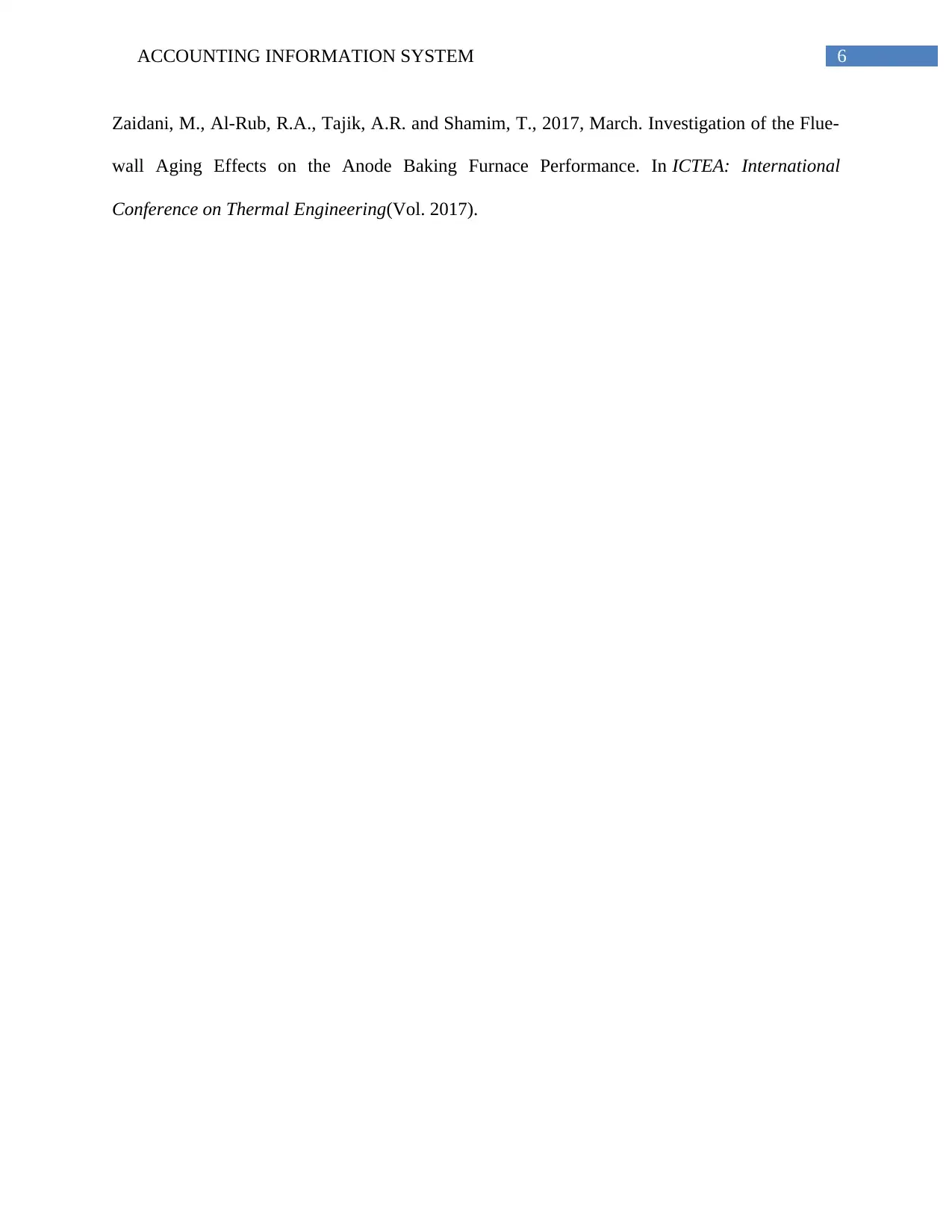
6ACCOUNTING INFORMATION SYSTEM
Zaidani, M., Al-Rub, R.A., Tajik, A.R. and Shamim, T., 2017, March. Investigation of the Flue-
wall Aging Effects on the Anode Baking Furnace Performance. In ICTEA: International
Conference on Thermal Engineering(Vol. 2017).
Zaidani, M., Al-Rub, R.A., Tajik, A.R. and Shamim, T., 2017, March. Investigation of the Flue-
wall Aging Effects on the Anode Baking Furnace Performance. In ICTEA: International
Conference on Thermal Engineering(Vol. 2017).
1 out of 7
Related Documents
Your All-in-One AI-Powered Toolkit for Academic Success.
+13062052269
info@desklib.com
Available 24*7 on WhatsApp / Email
![[object Object]](/_next/static/media/star-bottom.7253800d.svg)
Unlock your academic potential
© 2024 | Zucol Services PVT LTD | All rights reserved.





